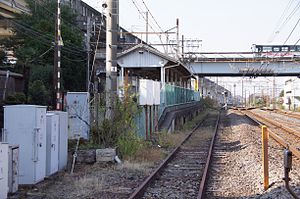Tobu Kumagaya Line
| Tobu Kumagaya Line | |
|---|---|
 Disused track of the former Tobu Kumagaya Line at Kami-Kumagaya Station in November 2011 | |
| Overview | |
| Native name | 東武熊谷線 |
| Owner | Tobu Railway |
| Locale | Saitama Prefecture |
| Termini |
|
| Stations | 4 |
| Service | |
| Type | Heavy rail |
| Depot(s) | None |
| Rolling stock | Tobu KiHa 2000 series |
| History | |
| Opened | 1943 |
| Closed | 1983 |
| Technical | |
| Line length | 10.1 km (6.3 mi) |
| Number of tracks | 1 |
| Track gauge | 1,067 mm (3 ft 6 in) |
| Electrification | Not electrified |
The Tobu Kumagaya Line (東武熊谷線, Tōbu Kumagaya-sen) was a 10.1 km single-track line operated by Tobu Railway, which ran from Kumagaya to Menuma in Saitama Prefecture between 1943 and 1983.[1][2]
History
Construction of the line was planned during the Pacific War to provide transportation for the military supply factories located in the area. It opened on 5 December 1943, although the shortage of materials during the war meant that the rails for the line had to be procured by singling the Tobu Nikko Line between Kassemba and Tobu Nikko Stations. The original plan to extend the line beyond Menuma over the Tone River to the freight terminal at Shin-Koizumi (on the now closed Sengokugashi Freight Line extending from the Tobu Koizumi Line at Nishi-Koizumi) was cancelled following the end of the war.[1]
The line was not linked to any other Tobu lines, and remained unprofitable. It was finally closed on 31 May 1983.[1]
Some of the former Kumagaya Line track remains in situ between Kumagaya and Kami-Kumagaya on the Chichibu Main Line, as does one of the concrete piers for the planned Tone River bridge, on the Gunma Prefecture side of the river.[3]
Stations
Source: [2]
| Station | Japanese | Distance (km) | Passenger statistics[Note 1] | Remarks |
|---|---|---|---|---|
| Kumagaya | 熊谷 | 0.0 | 1,716 | Staffed[Note 2] |
| Kami-Kumagaya | 上熊谷 | 0.9 | 150 | Staffed[Note 2] |
| Ōhata | 大幡 | 4.4 | 704 | Unstaffed |
| Menuma | 妻沼 | 10.1 | 1,452 | Staffed |
Notes:
Rolling stock

The line was initially operated using Class B2 (ex-JNR Class 5300) Beyer Peacock-built steam locomotives (numbers 27 and 28, ex-JNR 5312 and 5313) hauling former DeHa 1 electric cars converted to non-powered passenger coaches.[3] A fleet of three new KiHa 2000 series diesel railcars built by Tokyu Car was introduced from February 1954.[2] These were initially painted in JNR-style blue and cream, but from June 1963, they were repainted into the Tobu livery of "royal beige" and "international orange". From February 1972, the three railcars were repainted into the Tobu livery of all-over "sage cream".[2]
See also
References
- ^ a b c 歴史でめぐる鉄道全路線NO.5 東武鉄道2 [Railway Line History No. 5: Tobu Railway 2]. Japan: Asahi Shimbun Publications Inc. September 2010. p. 24. ISBN 978-4-02-340135-8.
- ^ a b c d Terada, Hirokazu (October 2003). 私鉄廃線25年: 36社51線600kmの現役時代と廃線跡を訪ねて 私鉄廃線25年 [25 Years of Abandoned Private Railways]. Japan: JTB Can Books. pp. 52–53, 167. ISBN 978-4-533-04958-3.
- ^ a b 東武鉄道熊谷線と那須電気軌道 [Tobu Kumagaya Line and Nasu Tramway]. Japan Railfan Magazine. Vol. 50, no. 590. Japan: Koyusha Co., Ltd. June 2010. pp. 128–135.
